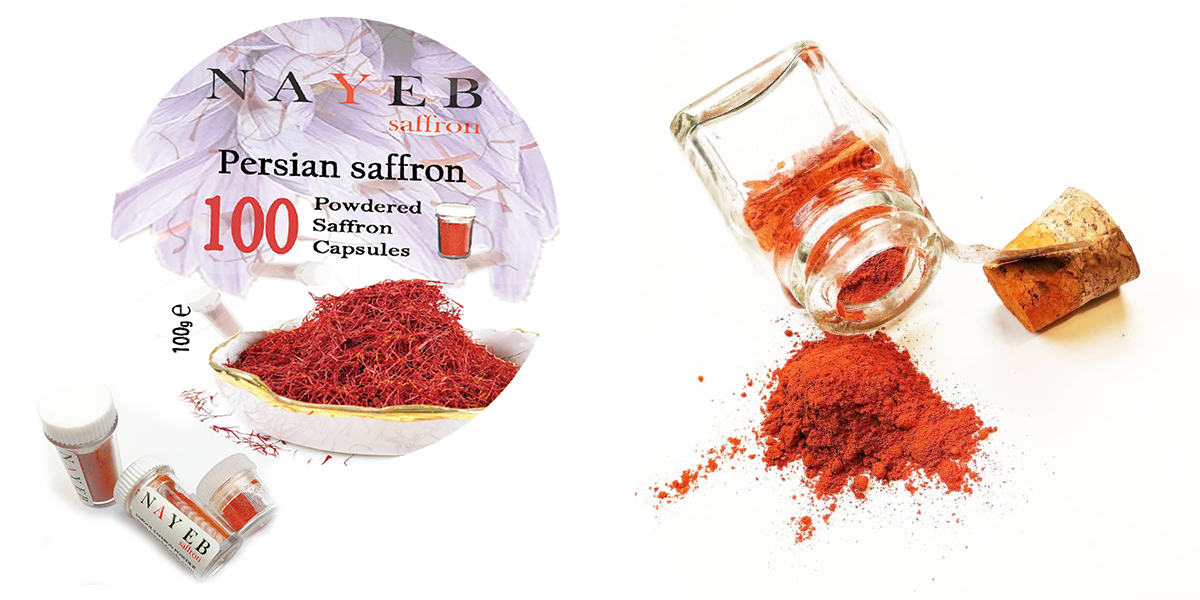SAFFRON POWDER
Premium all red saffron powder with rich red hue and intense aroma. A aromatic and medicinal spice suitable for many cooking needs.
Visual analysis: Red saffron powder without yellow parts.
Laboratory analysis (ISO 3632):
| Crocine | Safranal | Picrocrocin | Humidity | Total Ash | Non Solution Ash in Acid | |
| SAFFRON POWDER | >220 | >30 | >80 | <7% | <5% | <0,35% |
| ISO 3632-1 Cat. I | >190 | 20-50 | >70 | <12% | <8% | >1% |
Crocine: a compound that gives color to saffron and is used as an indicator of its quality.
The higher the number is: the more colour, flavor, and aroma will bring to your dishes and higher health benefits for your body.
A high level also indicates the date of the harvest: the last crop holds higher values as saffron qualities diminish significantly after 2 years of its harvest.
Picocrocine: compound responsible for the bitter taste.
Safranal: compound responsible for the aroma, is an effective anticonvulsant and antidepressant, and shows high antioxidant activity (cytotoxicity against cancer cells).
Humidity: Moisture decreases the flavor, the aroma, and the shelf-life.
Flower waste: floral waste consists of the parts of the saffron flower which contain none of the saffron’s properties.
Packaging:
Tins: 0.5g | 1g | 2g | 3g | 4g | 5g | 10g | 20g| 50g | 100g | 1kg
Glass jar: 2g | 3g | 4g | 5g | 10g | 20g| 50g | 100g
Bulk: 500g | 1kg (Bag & Zip bag)
Zip Bag: sealed to keep saffron freshness.
| PRODUCTS | Saffron |
| Latin Name | Crocus Sativus |
| Style | Dried |
| Form | Filaments |
| Color | Red saffron powder without yellow parts (All red) |
| Brand Name | NAYEB foods (from Iran to the Globe) |
| Part | Only Dried Stigmas |
| Source of Saffron | Iran, the world’s largest producer (by FAO & World Bank) |
| Place of Origin | IRAN |
| MOQ | Minimum 1kg |
| Packing | Consumer pack |
| Delivery time | 5 banking days after Order Confirmed |
| Shelf Life | 24 months |
The benefits of saffron may include:
Providing antioxidants
The majority of the health claims surrounding saffron relate to its high levels of
specific antioxidants.
● The main active antioxidants include:
crocin
picrocrocin
safranal
● Other compounds include kaempferol and crocetin.
These antioxidants help fight against oxidative stress and free radicals in the
body.
As oxidative stress and free radicals play a role in the development of many health
conditions, including cancer and heart disease, antioxidants such as these may
help protect a person’s health.
● Preventing nervous system disorders
The antioxidants in saffron may play a role in protecting the body from disorders
affecting the nervous system.
Compounds in saffron, such as crocin, appear to reduce inflammation and
oxidative damage in the brain, which may lead to beneficial effects.
A study in the journal Antioxidants noted that saffron might theoretically help with
Alzheimer’s symptoms due to both its memory-enhancing properties and its
antioxidant and anti-inflammatory effects.
People with mild-to-moderate Alzheimer’s who took saffron for 22 weeks had
cognitive improvements that were comparable with those of people who took the
drug donepezil, and they also experienced fewer side effects.
Boosting mood
There is also growing evidence that saffron may help improve mood and be a
useful addition to treatment for depression.
A study in the Journal of Behavioral and Brain Science found that a saffron extract
increased dopamine levels in the brain without changing the levels of other brain
hormones, such as serotonin.
●
Other research suggests that taking 30 milligrams (mg) of saffron each day could
cause similar effects as drugs that treat mild-to-moderate depression, such as
imipramine and fluoxetine.
Although some people recommend using saffron as a complementary therapy for
improving mood, it is too early to recommend it for treating depression
symptoms.
● Promoting libido
Saffron may also increase sex drive and sexual function in both males and
females.
Researchers reviewed the effects of saffron on male infertility problems and noted
that while it had a positive effect on erectile dysfunction and overall sex drive, it
did not change the viability of the semen.
An older study from 2012 looked at the effects in women who had reported
experiencing sexual dysfunction due to taking the antidepressant fluoxetine.
Women who took 30 mg of saffron each day for 4 weeks had increased sexual
desire and vaginal lubrication compared with those who took a placebo instead.
● Reducing PMS symptoms
Saffron may also act to reduce the symptoms of premenstrual syndrome (PMS).
The authors of a 2015 review looked at the research on saffron and symptoms of
PMS. Women between the ages of 20 and 45 years who took 30 mg of saffron each
day had fewer symptoms than those who took a placebo.
Additionally, women who simply smelled saffron for 20 minutes had lower levels
of the stress hormone cortisol in their system, which may also contribute to a
reduction in PMS symptoms.
● Promoting weight loss
There is also some evidence to suggest that saffron may help promote weight loss
and curb the appetite.
A study in the Journal of Cardiovascular and Thoracic Research found that taking
a saffron extract helped people with coronary artery disease reduce their body
mass index (BMI), total fat mass, and waist circumference.
People who took the supplement also had a reduced appetite compared with
those in the placebo group.
● Side effects and risks
In general, the consumption of saffron carries little risk. Cooking with saffron is a
great way to add it to the diet without the risk of consuming too much of this
spice.
Taking up to 1.5 grams of saffron each day is generally safe, but eating too much
can be toxic. Researchers consider 5 g to be a toxic dose.
While this is early evidence to support the medicinal use of saffron, researchers
suggested that future clinical trials could help back up these claims.
| NUTRITION FACTS | ||
| Principle | Nutrient Value/100g | Unit |
| Energy | 310 Kcal | 3.1 Kcal |
| Carbohydrates | 65.37 g | 0.65 g |
| Protein | 11.43 g | 0.11 g |
| Cholesterol | 0 | 0 |
| Total Fat | 5.85 g | 0.05 g |
| Dietary Fiber | 3.9 g | 0.03 g |
| Sodium | 148 mg | 1.48 g |
| Potassium | 1724 mg | 17.24 g |
| Calcium | 111 mg | 1.11 g |
|
* The % Daily Value (DV) tells you how much a Nutrient in a serving of food contributes to a daily diet. 2,000 calories a day is used for general nutrition advice. |
||



